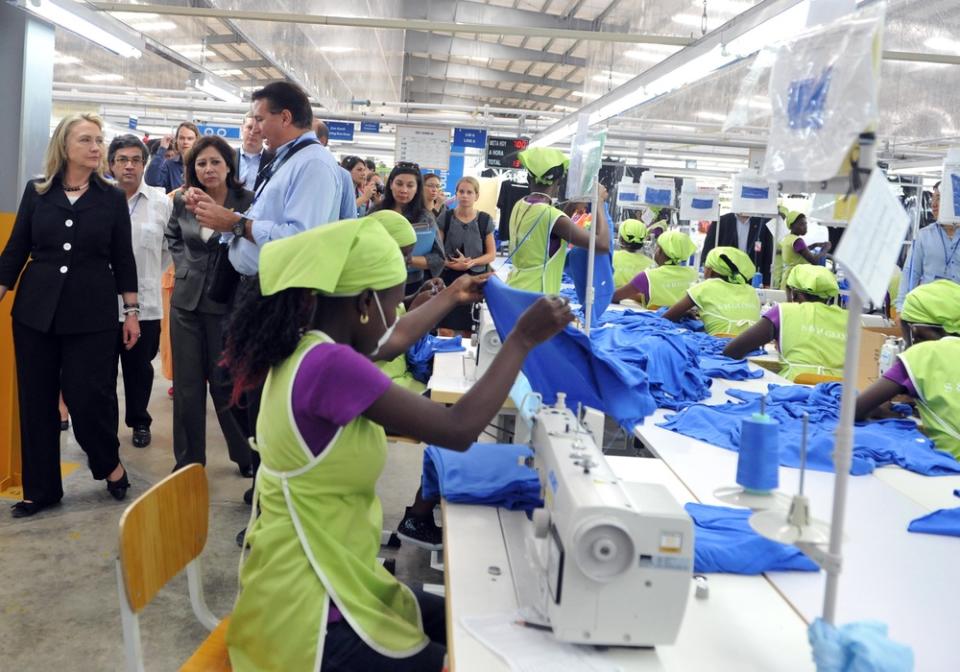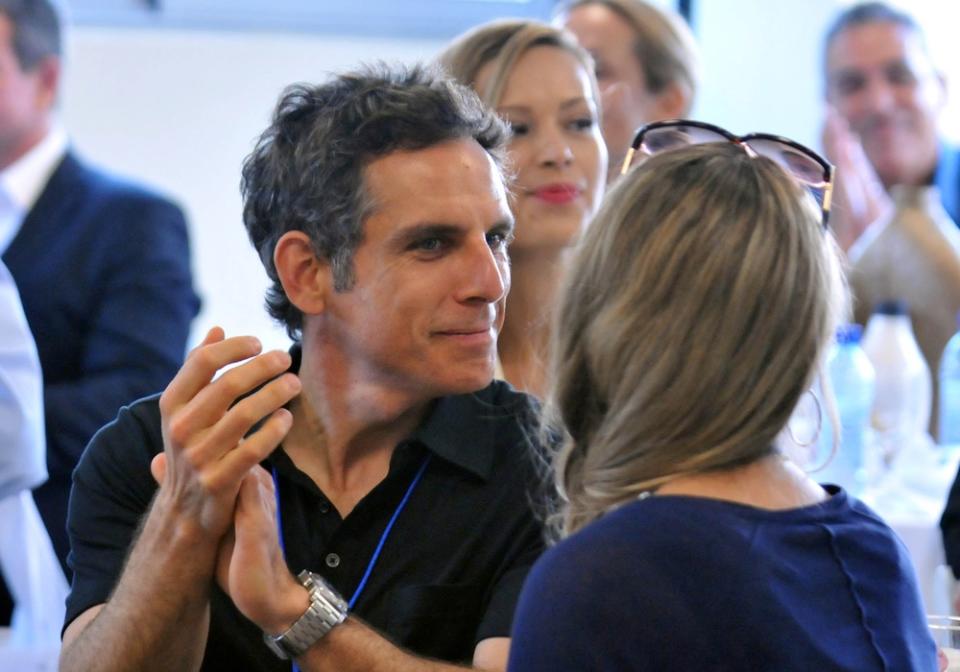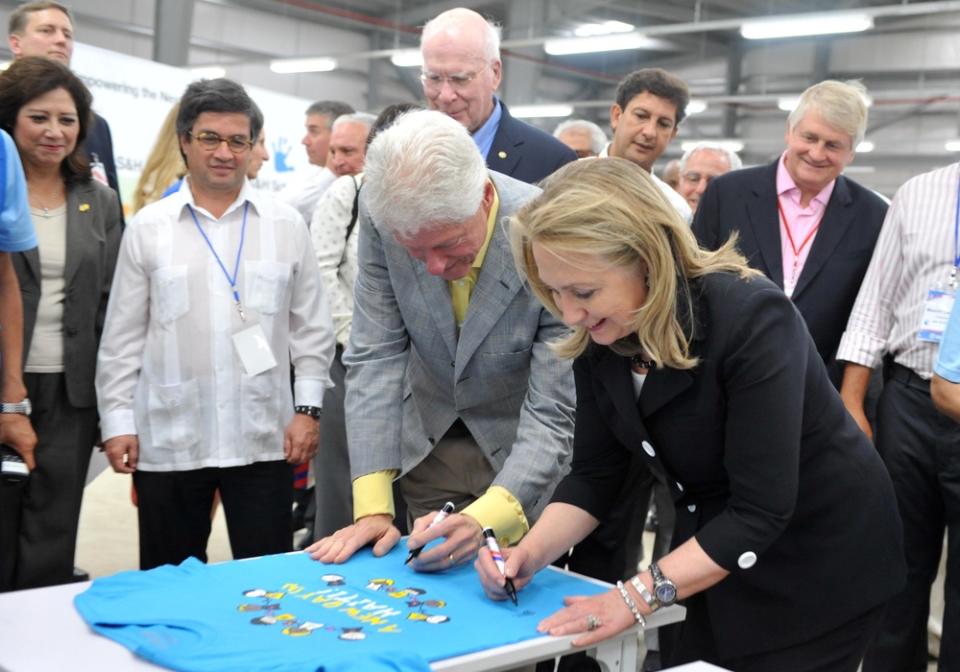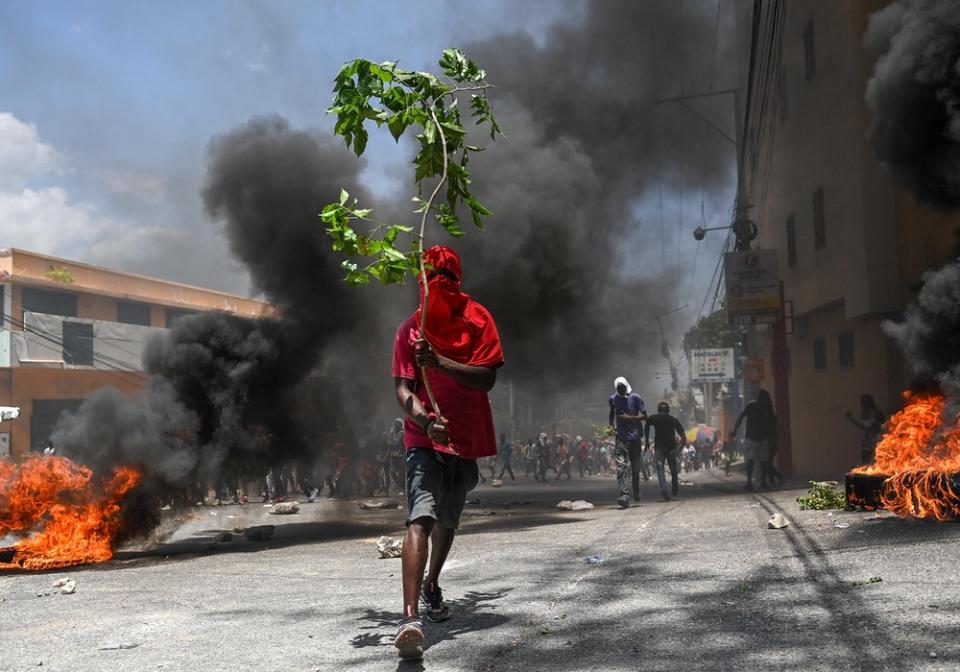From Promise to Poverty: What Went Wrong at Haiti’s Hyped Garment Park
- Oops!Something went wrong.Please try again later.
- Oops!Something went wrong.Please try again later.

The October 2012 inauguration of Caracol Industrial Park in northeast Haiti was a glittering, star-studded affair. Former U.S. president Bill Clinton, the United Nations’ special envoy for Haiti at the time, toured the sprawling 600-acre development, as did Hollywood activists Ben Stiller and Sean Penn, New York fashion designer Donna Karan, Czech model Petra Nemcova and British billionaire entrepreneur Richard Branson.
At an investor lunch afterward, the smell of paint and cured asphalt still fresh in the air, then-Secretary of State Hillary Clinton waxed lyrical about the $300 million facility’s role in rebuilding Haiti following the devastating 2010 earthquake, which killed more than 200,000 people and left another 1.5 million homeless. She praised the Inter-American Development Bank for shepherding the project, which was fast-tracked in the wake of the disaster, and thanked South Korean clothing manufacturer Sae-A Trading for taking the “risk” of anchor tenancy under the name of S&H Global, despite having never worked in the country before.
More from Sourcing Journal
It was remarkable, Secretary Clinton said, that the corner of the Caribbean in which they were standing was a construction site bereft of any structures mere months ago. Now flush with land from the Haitian government, infrastructure paid for by the development bank, equipment and expertise from Sae-A and plans for housing, a power plant and a port courtesy of the U.S. Agency for International Development, it fizzed with potential. The park would be able to generate 65,000 new jobs, driving economic recovery while easing congestion in the rubble-strewn capital of Port-au-Prince in the south. The school that Sae-A offered to build would provide hundreds of workers’ children with a free first-rate education.
“As we walked through the factory and saw some of the more than 1,000 Haitians working here, many of whom are women who have never held a job in the formal economy before, I could think, as I do all over the world, what that will mean to their families and their children,” she said. “Children will go to school, will be healthier, will have more of their own dreams fulfilled because their mothers had good jobs. So this is, indeed, a great day, not only for those who are already working, but for those who they are supporting.”
But the “great day” was already marred by controversy. Secretary Clinton failed to mention that a year before, the Haitian government evicted more than 420 smallholder farmers and their families, with only a few days’ notice and compensation that quickly ran out, to make room for the park. Nor did she bring up the fact that the AFL–CIO, the largest federation of unions in the United States, had urged American and international stakeholders to rethink the deal, citing Sae-A’s anti-union repression and “acts of violence and intimidation” in Guatemala, where it had shuttered a flagship factory in 2011 following a labor dispute. The manufacturer would later dismiss the claims as unfounded.
Critics also pointed out that the Trou du-Nord River, which runs through the Caracol Industrial Park, feeds into Caracol Bay less than a mile away, putting Haiti’s second-largest mangrove forest and an extensive yet fragile coral reef in direct conflict with the sudden influx of polluting activity, including wastewater discharge and industrial emissions. Locals, including Caracol mayor Landry Colas, said that they weren’t consulted about the facility’s potential location, which had been shortlisted by an American consulting firm and erroneously described as “devoid of habitation and intensive cultivation.” The Haitian government ultimately made the decision to greenlight the area.
‘Poorer and poorer’
More than a decade later, many of Caracol Industrial Park’s once-vaunted promises feel like a bait and switch. The power plant delivered a stable source of electricity, yet people in the area complain they’re being charged more than Haitians elsewhere. Plans for the new port, once considered central to the development’s success, were abandoned, as was a subsequent decision to upgrade and expand an existing one in nearby Cap-Haïtien. Ambitions for the country’s first knitting mill, which the park’s backers once regarded as crucial to its success, likewise evaporated. Workers accused managers of sexual harassment and rampant wage theft. Only a fraction of the professed jobs—15,000 at best—materialized and even this number is falling by the day.
Telemarque Pierre, coordinator of the workers’ union SOTA-Batay Ouvriye, said that Haitians are worse off now than when the Inter-American Development Bank, Sae-A and the Clintons broke ground on the development more than a decade ago.
“Instead of improving conditions, people became poorer and poorer,” he said through a translator.

Haiti’s broader woes have only compounded the situation. Exacerbated by ruthless gang violence that has spiraled out of control since the 2021 assassination of President Jovenel Moïse, the already impoverished nation has plunged into its worst humanitarian and security crisis in years, with a de facto prime minister but not a single democratically elected official. Kidnappings, particularly of women and children, now happen with alarming regularity. Coupled with the continuing fallout from Covid-19, a global cost-of-living crisis propelled by the war in Ukraine and inflation that surged past 46 percent in May, manufacturers at the development, including S&H Global, are grappling not only with fuel shortages but also plummeting business from a chaos that shows no signs of abating.
“Some factories have had to close because they have fewer orders and they have also issues in receiving raw materials,” Pierre said.
Despite the slew of incentives and tax exemptions it received, S&H Global struggled against those headwinds, admitted Karen Seo, a Sae-A spokeswoman. The pandemic caused orders to fall precipitously, while “severe” challenges securing fuel and electricity obstructed operations. In late 2022, S&H Global was forced to halt operations for two entire months, just before the critical holiday season, after an armed blockade at the main fuel terminal in Port-au-Prince prevented oil from reaching Caracol’s power plant and paralyzed production.
“This setback resulted in losses amounting to tens of millions of dollars, including out of pocket, as well as canceled, undeliverable and delayed orders,” Seo said.
Many of its buyers have also requested that orders be rerouted to more “reliable” factories in the Caribbean and Central America. As a result, S&H Global has downsized from its original seven modules to five, relocating workers from one plant to another to “enhance operational efficiency while minimizing workforce reductions.” But it still lost workers. At the development’s inauguration, Sae-A made a lofty goal of creating 20,000 jobs by 2016. S&H Global would end up hiring 11,000 at the height of its operations. Now, it employs 5,500, though Seo attributes some of the attrition to “voluntary” resignations.
“Despite the challenges, Sae-A has been diligently working to sustain S&H Global’s operations and preserve jobs for our workforce,” she said. “However, the adverse impact of the inflationary environment in the United States has compelled us to consider further reductions in our operations.”
Trade data suggests that S&H Global’s clients include Gap Inc.-owned Old Navy, Walmart and, until 2018, Kohl’s. Kohl’s said it no longer produces in Haiti though it would not explain further.
Pierre said that some of S&H Global’s workers who have been placed on reduced hours—say, three days a week instead of the usual six—are indeed considering quitting, appealing for severance and then hoping for the best. Less work, he said, means a smaller income and food insecurity, aggravated by soaring prices, is an increasingly urgent concern. “This is a really big challenge for them to take care of their families,” he said. The World Food Programme estimates that nearly one in two Haitians, amounting to 4.9 million people, is going hungry every day.
Wanted: jobs with dignity
Megumi Tsutsui is the interim communities co-director of the Accountability Counsel, a San Francisco-based nonprofit that represents the thousands of Haitians who were pushed out by Caracol Industrial Park. They’ve since organized themselves into a bargaining unit known as the Kolektif Peyizan Viktim Tè Chabè, or the Kolektif for short.
Previously, the community might have been able to ride out the hunger crisis since they were able to grow their own food and raise their own livestock, Tsutsui said. The park robbed them of that. “This big development project was built on what was some of the most fertile lands in this area, and as a result, the people were driven into pretty deep poverty,” she said.
After the Kolektif appealed to the Inter-American Development Bank’s independent complaint mechanism in 2017, it arrived at a settlement with the development bank and representatives from the Haitian government that would provide the displaced families with a combination of land, employment, agricultural equipment and training, and support for microenterprises focused on women and other vulnerable members of the community. The development bank also agreed to engage a laboratory to perform independent water analyses of the Trou du-Nord River, the results of which they would share with the Kolektif and publish online.
Again the assurances fell short, Tsutsui said. To date, less than half—42—of the original 100 farmers who were assured land have received it. And as far as the Kolektif can tell, no regular water monitoring is taking place.
“I think agreeing to remedy harm is an important first step, but then they actually have to remedy that harm,” she said. “It’s important to have the mechanisms there to raise complaints and I think sometimes they can be used effectively, but then what we want to see is actual follow through and accountability on these issues.”

Wilson Menard, one of the evicted farmers, feels a sense of loss—and betrayal. Previously, members of the Kolektif were able to live off the land, earning extra money by selling surplus crops in the marketplace. Now they have practically nothing. The facility also drew thousands of people to Caracol, yet without a corresponding increase in the number of roads, hospitals or public schools for the general populace, they have strained existing resources to their breaking point.
Irony echoes through the land itself. The site of the park was once a labor camp used by the Marines during the U.S. occupation of Haiti from 1915-1934.
Menard said that the park’s developers had promised to prioritize hiring from the community so they could transition away from the agricultural work that they could no longer do, yet only 70 members of the Kolecktif have managed to get jobs there. Of these, not one is a managerial or supervisory position, which would provide better pay.
“One person from every household should have a job at the park,” he said through a translator. “They should be able to support their families.”
Even so, work at Caracol Industrial Park has been a mixed bag, according to assessments from Better Work Haiti, an International Labour Organization and International Financial Corporation-backed program whose formation in 2009 was a condition of the Haitian Hemispheric Opportunity through Partnership Encouragement Act of 2008, the trade preference program better known as HOPE. Its reviews of S&H Global regularly log cases of misconduct, including sexual harassment and violations in occupational health and safety, compensation and working hours, though Sae-A’s Seo said that the company maintains close communication with Better Work Haiti and the Ministry of Social Affairs and Labor to “promptly address any non-compliance issues and consistently improve the work environment.”
“Transparency and collaboration with relevant stakeholders are pivotal in rectifying issues and preventing their recurrence,” Seo said. “Minor issues are identified but the monitoring system provides the opportunity to not only identify problems but to [also] implement corrective action plans and in most if not all cases to date, matter[s] are resolved to the auditing firms’ satisfaction.”
Seo said that Sae-A believes in being a responsible neighbor. The S&H School, she noted, has enrolled 700 children, part of its ambition to “secure a better future for generations in Haiti.”
“We remain steadfast in our dedication to the region’s and the country’s future,” she added.
Others are less sure. “From the community’s perspective, I think they both want these jobs and want this industry to be healthy, but they also want the jobs that it provides to be respectful and dignified [so they’re] able to earn enough money from them to pay for their basic needs [while being] treated with dignity and respect,” Tsutsui said.

The Inter-American Development Bank continues to throw money into the park. In 2021, it approved another $65 million in financing to expand the site, putting its total investment at $263.5 million. Warehouse space, it said, would increase to “satisfy the additional demand” of current tenants and promote innovation and local entrepreneurship. The money would also go toward establishing a professional entity that would manage the development, as well as the formation of an environmental, social, and health and safety team.
On a recent visit to Caracol Industrial Park, however, Tsutsui saw heaps of rubbish being burned all across the facility, sending plumes of smoke billowing to areas where people lived, ate, worked and slept.
“There’s constant burning of the park,” she said. “We were wearing N95 masks and then for like an hour afterward, my throat was still sore from breathing in whatever was burning at the park. There’s no discernible impact on the ground that the communities can see.”
The Inter-American Development Bank said that it recognizes “ongoing challenges” that have been raised related to the operation but that it remains “committed to the positive benefits for Haiti.” The bank “will, as customary, be attentive to the execution of the project, in continuous dialogue with the executing agency,” it said, referring to the Ministry of Economy and Finance’s Technical Implementation Unit, or UTE. UTE did not respond to a request for comment.
A lack of accountability
For decades, cheap labor, strategic location and duty-free access to the United States made Haiti a popular sourcing destination for the likes of Calvin Klein, Fruit of the Loom, Gap Inc., Gildan, Hanesbrands and Walmart, particularly when it came to low-value knit and woven apparel such as T-shirts and underwear. The garment industry now accounts for 90 percent of the island nation’s total exports, most of it America-bound.
The starting wages for Caracol Industrial Park’s workers were set at the legal minimum, but the threshold didn’t budge above 500 gourdes a day, or $3.66, until 2022, leaving more than half the population languishing below the World Bank’s poverty line. After mass demonstrations swept the country, the government hiked the floor pay by 37 percent to 685 gourdes a day ($5), short of the 1,500 gourdes ($11) union leaders were demanding and less than the 1,750 gourdes ($12.80) experts say would provide a living wage. While a 2022 study from the Solidarity Center found that less than a quarter of Haiti’s workers were able to adequately provide for themselves and their families on what they made in a 48-hour workweek, things are almost certainly more dire today.
“When we did the living wage study, it [was] assuming that everyone has a full schedule, but that is so far from the truth now,” said Jen Bognar, its program officer of the Americas region. “So imagine having four times less than what you need to survive and only working maybe half the days that you’re supposed to in some cases.”
Bognar said that workers’ testimonies about HOPE and its adjacent act, the Haiti Economic Lift Program, a.k.a. HELP, both of which are up for renewal in two years, carry a common thread.
“They’re saying, ‘We like the programs that bring the brands to Haiti, but there’s no accountability in the sector,’” she said. “The brands don’t enforce labor rights. They don’t name the international finance institutions but the international finance institutions aren’t enforcing labor rights. The government of Haiti isn’t capable of enforcing labor rights. So who’s going to do it?”
Indeed, interventions on behalf of Haiti’s workers are rare: When Hanesbrands disbursed $330,000 to workers who were left hanging after one of its suppliers, GO Haiti, boarded up its doors last October, the move was widely lauded. Calvin Klein owner PVH Corp. garnered even more attention in January when it agreed to distribute $1 million among the axed employees of Vald’or, a Port-au-Prince supplier that made clothing for its licensee Centric Brands, one year after the factory’s closure. In both cases, the largesse saved the workers from almost certain destitution, but it doesn’t always turn out this way.
“This is kind of the constant struggle where a better work system exists—the HOPE law created a mediation office and other ways to deal with labor issues as they come up—but still, there’s so little compliance,” Bognar said. “It’s so common to not pay into the pension system or the healthcare system or severance because they just get away with it. It’s kind of rare to get justice like this. And now it’s even harder because it’s so difficult to operate in Haiti. It’s already so easy for these companies to say, ‘Well, it will be easier for me just to pull out of Haiti.’”
Bognar said that workers’ unions and civil society groups like hers have been urging brands to hold their suppliers accountable and pushing the U.S. government to use the trade preference programs as a tool to compel compliance. There’s a looming concern that if the HOPE and HELP schemes lapse, companies will further retreat from Haiti.

So far, few if any brands, including those aforementioned, have been willing to comment about their sourcing plans in the beleaguered nation. A VF Corp. spokesperson said that the company is troubled by the “declining situation in Haiti and will continue to evaluate the scope of our business in the country in the context of the ongoing risks.” In a recent joint letter from several retail trade groups, including the American Apparel & Footwear Association and the National Retail Federation, suggested that several factories and buyers are “making decisions now about whether to continue doing business in Haiti.” Every month that goes by without a reauthorization, it said, increases the risk of factories and buyers leaving the country and, in fact, some already have.
“Brands have benefited from the labor of Haitian workers for so many years and now that things are difficult, they can’t just pull away and maybe they’ll come back if things improve,” Bognar said.
By creating unstable jobs, international finance institutes are “contributing to the instability,” she said. “You can’t just create an industrial park and be like, ‘Well, what happens in the park is not my business.’”
The problems extend beyond Caracol. In 2021, a hearing by the House of Representatives Committee on Ways and Means heard testimony noting that 84 percent of Haiti’s factories have failed to send deductions from workers’ wages to the respective health insurance and social security agencies between October 2019 and September 2020, as required by Haitian law. As a result of being denied the emergency medical care to which they should have been entitled, at least two workers, including a woman and her unborn child, died in 2020, witnesses said.
Many of Haiti’s problems stem from long-term international meddling, said Kristina Fried, Bertha Justice fellow at the Institute for Justice & Democracy in Haiti, a nonprofit based in Boston.
“Foreign companies, states, whatever it may be, come in, they prop up the undemocratic regimes that serve their interests and their agenda without prioritizing or safeguarding the human rights and the needs of the Haitian people,” she said. “And then when those regimes that they’ve propped up foster conditions that create a humanitarian crisis, these same companies, states, whatever, say, ‘O.K., well, we’re going to pull out. Haiti is too unstable. We can’t be here.’”
Fried said that Caracol Industrial Park was established as an almost humanitarian endeavor to rebuild Haiti after the earthquake. In reality, however, it hasn’t given Haitians autonomy over their livelihoods or their economy. Those are in the hands of foreign companies and the international community.
The problem with brands swooping in to workers’ rescue after a factory closes without providing sufficient notice or adequate compensation is that something like that should never have happened in the first place, she said.
“Redress should have been given to those workers immediately,” Fried said. “And a big problem that I see with it is also that these brands come in afterward and it’s almost treated like charity. They say, ‘O.K., we’re going to fix this problem. We’ve listened to you, here’s a bunch of money.’ But it’s not treated as a violation of rights.”
That goes for initiatives like HOPE and HELP, too. “Part of the problem with these trade programs is that they don’t really create long-term growth for Haiti,” she said. “They make it very cheap for American companies to operate here. But they’re not giving any incentive for high-value products to be made in Haiti. And they’re not creating an incentive for companies to help [Haitians] own a larger part of the manufacturing process…[and create] jobs that don’t lead to the widespread labor violations.”
Rolinx Altidor, coordinator at the Autonomous Democratic Central of Haitian Workers, or CEDATHA, a union based in Caracol, said that Haitians are willing to work. Whether their jobs can sustain them, particularly through the country’s current turmoil, is another matter.
“We need our rights enforced, which is not the case,” Altidor said through a translator. Many workers, he said, are paying for food on credit. And where that’s not possible, they’re taking out loans at exorbitant interest rates. If buyers start withdrawing from Haiti en masse, conditions will only deteriorate.
For him and others, that day in 2012 feels almost like a fever dream. When Caracol Industrial Park officially threw open its doors, then-Haitian president Michel Martelly proclaimed with great fanfare that the country was “open for business.” Now those words ring hollow.
“They made a lot of promises but they never keep them,” Altidor said. “None of them have.”

